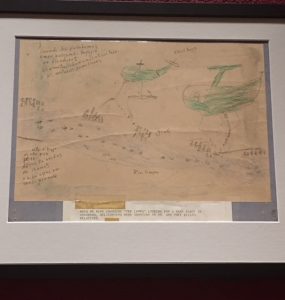Hello ASTU G02! I had an incredible experience in reading everyone’s first blog posts!
Although I am a class blogger, I also had the opportunity to visit the Museum of Anthropology and the exhibit, the Arts of Resistance, curated by Dr. Laura Osorio Sunnucks, an expert in Mesoamerican art and heritage. While I formed my own interpretations and reflections on the artifacts and art pieces, reading my fellow classmates’ posts opened up new perspectives for me through the sharing of their personal connections in relation to the exhibition we were tasked with exploring.
I particularly found my classmate Aleksei’s personal connection to the exhibit to be very unique in the topic of foreign influence in his blog, especially that of the United States. He mentions many other political battles in Latin American countries, such as “Brazil’s far-right presidential candidate Jair Bolsonaro” in order to provoke a sense of commonalities in the global scale of political turmoil. He shares his interpretation of an art piece depicting American influence with the Peruvian government of the killings of Peruvian natives, and his expression of dissatisfaction with those actions taken, while also relating to how it connected to his family, in particular to that to his uncle. He was able to express a strong bias against the American colonial tendencies but also criticizes it, because of the possible biases that his memories are influenced by, particular because of his personal connection to it. Another one of my classmates also made a personal connection with Latin American politics in her blog post, as she came from a Latin American country herself. Mirella was able to create a sense of solidarity in terms of the cultural representations of the “political realities” in Latin America.
Relating back to the ASTU course theme on the intricacies of memory, both Aleksei and Mirella, and among other blog posts, incorporated “different performances of self towards different audiences”, and personal memory in relation to the exhibit, and from the exhibit, to a film that we focused on, Stories We Tell. Many of the artworks created were based on the subjectivity of the artist’s own memory, as Kriveen had suggested in her post, such as one from a child who had made a drawing of helicopters shooting at Salvadoran people. Suggesting that “As the audience, we have to interpret the truth from the art.” and whose memory we draw from to find that truth.

I found that many of my fellow classmates took particular interest in one display, understandably named, The Defence of Maize. Besides the economic implications of the intervention of maize modifications by GMOs, Moha had an interesting reflection on the exhibit, bringing in the cultural importance of maize. She initially explains that because of state intervention on maize, the lowered price of transgenic crops causes “the market and making non-transgenic maize production too unprofitable to continue”, and therefore, threatening the “cultural significance of many Mayan traditions and legends”. Similarly, Tracy also recognizes the historical value of the maize to the Indigenous groups, and the economic impediment farmers and loss of “historical ownership” are the results of the actions to takeover maize cultivation by the state. Interestingly, Tracy notes the canvas in which the exhibit was created on through the use of graffiti stencils, which is also a form of resistance in itself. She inquires further, that there is incentive to resist state oppression with graffiti, “painted on colonial walls” as a form of art and expression. Another classmate brings the layout of the exhibit as a important factor as well into her blog, Venus describes the graffiti stencils with 3 layers of components, placing importance on “the artist, the audience and the (meaning of) artwork.” Many blog posts reflected on the same exhibit, with many similarities regarding economic issues and cultural importance of the maize, along with their own interpretation of how those issues were represented.
As a class, we also had the amazing opportunity to talk with the curator Laura herself, during the CAP joint lecture on October 3rd. Laura went into very specific details on her thought process while she was bringing in authentic pieces for the exhibit. The idea of representation that she emphasized during her presentation allowed us to understand the importance of giving her privilege to speak, to the marginalized people who could not, through this exhibit. Women from Latin America got the opportunity to represent themselves, by telling their own stories and painting the murals.
By reading the blog posts, I was able to see common themes of political oppression, representation of memory and historical accounts based on memory, and resistance through cultural art. Even if I was unable to visit the museum, the interpretations of the displays, and reflection of personal connections would have allowed me to understand the importance of resisting political oppression in Latin America with powerful and vibrant art. Although the focus of the exhibit was about Latin America, cultural art can be a powerful political statement, regardless of where it is on the globe. In my own conclusion, I believe that our theme of memory in our ASTU class was demonstrated by how our classmates all had a slightly perspective and focus on the exhibit, through how they recalled their own memory and reflections of the displays while they wrote their blogs, and their own unique personal relationships to it.
It was definitely a fun experience to write a blog like this! Until next time!
-Jessie Y.
